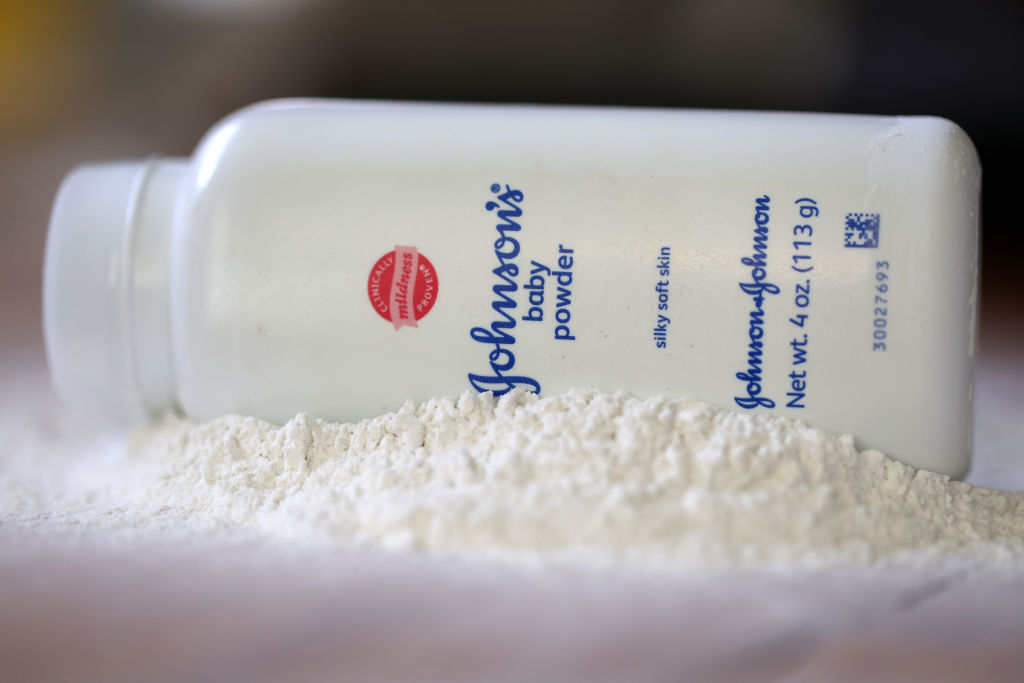Court Rules Johnson & Johnson Can’t Dodge Cancer Claims by Filing Bankruptcy
Johnson & Johnson has been a literal household name for decades, filling our cabinets with consumer goods, from medicines to soaps. For many of us, it’s even more nostalgic, as the pharmaceutical giant has long been a leading maker of toiletries for infants. You may remember, in particular, J&J’s iconic baby powder—and you may have been horrified by news of the recent litigation against the company after the powder was connected to cancer. The company has been facing tens of thousands of legal cases against it and has attempted some sneaky moves to weasel out of legal and financial liability. Luckily, courts have been skeptical of J&J’s antics to avoid paying up.
Talc in Baby Powder Possible Carcinogen
Talcum, or “talc,” the ingredient in many varieties of baby powder (including J&J’s), was recently connected to ovarian cancer in women, getting their makers in legal trouble for product liability. Consumers of J&J’s specific line of baby powder have alleged that the product has caused their cases of cancer, and some of the allegations went to court.
In a 2018 trial, for example, a St. Louis jury found in favor of 22 women plaintiffs who developed ovarian cancer, finding that the talc-based products contained asbestos that led to the disease—and the eventual deaths of six of the women. The original award of damages from the jury was nearly $4.7 billion, although a state appellate court later reduced that amount to a little over $2 billion. In the subsequent years, J&J has continued to face other lawsuits stemming from alleged injuries—namely, ovarian cancer—caused by their products.
J&J Dances the ‘Texas Two-Step’
At some point, the pending talc cases against J&J numbered approximately 38,000, and the company faced $3.5 billion in lawsuits filed by plaintiffs alleging its talcum products cause cancer. Faced with a litany of litigation, the healthcare giant threw its resources into building an entire team of more than 30 experts and employees dedicated to finding a way out of the financial blows—doing so under rather covert ops. The team attempted to find a loophole via the bankruptcy route, as a strategy to relieve itself of liability, in a stealthy scheme that was internally dubbed “Project Plano.”
In a legal maneuver that has come to be known as the “Texas Two-Step,” the company aimed to shift the liability from the thousands of pending cases onto a newly created subsidiary, which would immediately declare bankruptcy. The subsidiary, called LTL Management, was created as a limited liability corporation by the parent, J&J, solely for the purpose of relieving the latter of financial legal liability.
In this strategy, the first step is for a parent corporation to create a subsidiary of itself, and then transfer the parent’s existing tort liabilities to the subsidiary. Since Texas’s state laws tend to be corporation-friendly, many companies will register the “fake” subsidiary there, giving the move its name.
Then, the subsidiary files for Chapter 11 bankruptcy. Once the subsidiary declares bankruptcy, the dispute over the tort liability (in this case, cancer lawsuits from talc) must then be resolved through the bankruptcy process. (This means using bankruptcy court instead of a traditional court with a jury trial or settling the case out of court with the plaintiffs, both of which are expensive). J&J is thus shielded from tort liability by passing the buck to the subsidiary.
Moreover, since the parent company is legally a separate entity from the subsidiary, any resolution reached in bankruptcy court cannot take advantage of the assets of the parent. Therefore, not only is J&J shielded from fighting a tort case, but its deep pockets are protected from its subsidiary’s bankruptcy case as well.
The Texas Two-Step is not uncommon for companies to try when facing litigation that will likely make a sizeable dent in their coffers. Since 2017, law firm Jones Day has counseled J&J and three other companies—Georgia-Pacific, Saint-Gobain, and Trane Technologies—in executing this practice.
If successful, this two-step would shield both J&J and LTL from liability in $3.5 billion-worth of product liability lawsuits. This bankruptcy strategy “threatens the tort recovery of tens of thousands of talc claimants” by dramatically altering the typical nature of corporate accountability in product liability lawsuits. A successful bankruptcy by J&J would also create more caselaw serving as precedent for the legitimacy of such a strategy.
Not So Fast, Say the Courts
LTL had filed for bankruptcy in Trenton, New Jersey, where J&J is based, in a federal courtroom overseen by U.S. Bankruptcy Judge Michael Kaplan.
When the case appealed, LTL had requested that the 3rd Circuit Court of Appeals in Philadelphia wait to hand down its ruling until the J&J subsidiary could pursue a U.S. Supreme Court Appeal. Instead, the appellate court directed Judge Kaplan to dismiss LTL Management’s filing for bankruptcy, finding that the subsidiary was not in financial distress and did not qualify for bankruptcy protection.
In February, Judge Kaplan indicated that he was prepared to end the bankruptcy case. Once the bankruptcy case is dismissed, it is likely that the tens of thousands of pending product liability lawsuits against LTL will proceed. The plaintiffs in those cases would then be allowed to pursue recovery of damages for the injuries they allege J&J-produced talcum caused them. In that case, J&J will ultimately have to pay out the massive amounts of legal damages it originally faced, even if nominally through its subsidiary LTL. Ultimately, it looks like Daddy Johnson will still be footing the bill.
You Don’t Have To Solve This on Your Own – Get a Lawyer’s Help
Meeting with a lawyer can help you understand your options and how to best protect your rights. Visit our attorney directory to find a lawyer near you who can help.






